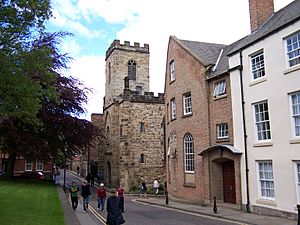Durham Museum, Durham facts for kids
The Durham Museum was a special place in Durham, England. It used to be called the Durham Museum and Heritage Centre. This museum told the story of Durham City, from olden times in the Middle Ages right up to today.
The museum was inside an old church called St Mary-le-Bow. This church was very close to famous landmarks like Durham Cathedral and Durham Castle, which are both World Heritage Sites. The museum closed in 2024 because it cost too much money to keep the old building in good shape. Many helpful volunteers ran the museum.
Inside, the museum had many interesting things to see. There were old objects, models, pictures, and even audio and video displays. These exhibits showed what life was like in this ancient city. Durham was once a strong, walled city, a place where people went on religious journeys, and the home of powerful Prince Bishops.
Many displays focused on the industries and businesses Durham was known for. This included making organs, which is still done there today. Besides the regular exhibits, the museum also had special shows about different parts of Durham's history. Visitors could also try making brass rubbings and buy souvenirs from the shop.
Contents
The Museum's Home: St Mary-le-Bow Church
The building that housed the Durham Museum has a long and interesting past. The church you see today was rebuilt in the 1670s. It replaced an even older church on the same spot that had fallen down in 1632. Because it was rebuilt using parts from different times, it has a mix of old and newer styles.
For example, the roof is from the 1400s, and some of the wooden panels inside are from the 1700s. Long ago, in the Middle Ages, an arch connected the church tower to the city's walls. This arch created a "bow" shape. Sadly, this arch collapsed in 1635.
The church building was in ruins for many years until 1685. People in the area tried to save it, but it was a big job. The rebuilding finally started with help from the Bishop of Durham and the leaders of Durham Cathedral. The church tower we see now was built in 1702. It holds a bell made in 1759.
Inside, the church has beautiful wooden carvings. The altar rails and a wooden screen are very old, dating back to 1705 and 1707. More wooden panels were added in 1731. Ten years later, in 1741, a west gallery and a small room for the clergy were built. The church closed in 1968, and some of its old fittings were removed. Even though parts of the building are very old, most of what you see today was built in the 1600s.
The church building was closed in 1968. Then, the Durham Museum opened its doors in 1972 and welcomed visitors until 2024.
The Bow Trust: Keeping History Alive
The Bow Trust (Durham) Limited is a charity that started in 1975. A charity is a group that helps others and doesn't make money for itself. The trust's main goal was to take care of the old St Mary-le-Bow church. They wanted to turn it into a place where people could learn about the history and culture of Durham City and the wider county. This led to the creation of the Durham Museum, which the trust managed inside the old church building.
Sculptures by Fenwick Lawson
Fenwick Lawson is a talented artist from the local area. He created three sculptures that were displayed at the Durham Museum.
- Cuthbert of Farne: He made this sculpture in 1984 and gave it to the museum in 2004. You can see a bronze copy of this artwork at Lindisfarne Abbey.
- Gaia: This sculpture was also made in 1984. It is named after the goddess of the Earth. Fenwick Lawson gave this piece to the museum in 2011.
- Jacob Wrestling with an Angel: His most recent gift to the museum showed the Bible story of Jacob wrestling with an angel.
External Links


